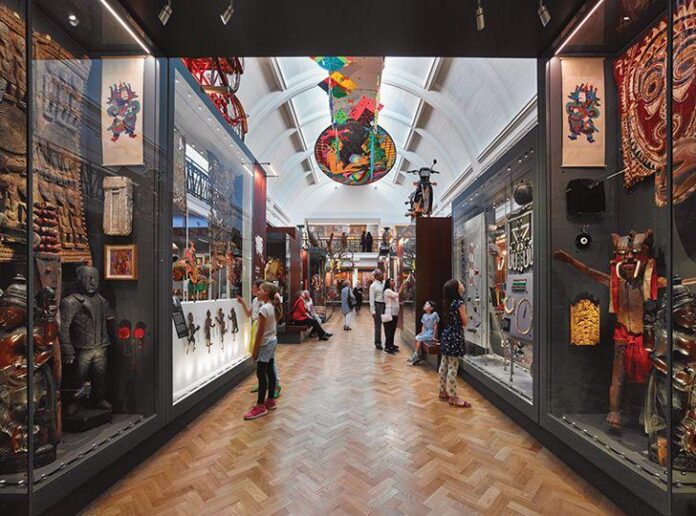• Read about the museums shortlisted for the Art Fund Museum of the Year 2022 here
The Horniman Museum and Gardens in Forest Hill, south-east London, is an institution of its time looking—with optimism—towards another. A diverse collection, spanning natural history, anthropology and one of the most important holdings of musical instruments in the world, is housed in a purpose-built limestone building topped by a distinctive round-cornered clock tower. This idiosyncratic site is the product of the collecting frenzy of Frederick Horniman, the Quaker heir to a Victorian tea company.
Horniman had previously stored his expanding collection in the family home, opening its doors to the public twice a week. Legend has it that his wife declared that it was either the collection or her. Horniman opened the new museum in 1901 and gifted it to the public. Today, the museum and its expansive gardens are Grade II*-listed and run by a charitable trust.
While the museum’s colonial-era origins have never been hidden, they were cast in a new light following the rise of the Black Lives Matter movement and the toppling of the statue of Edward Colston in Bristol. Research into the history of the founder’s fortune was instigated by Nick Merriman, the Horniman’s chief executive and director of content since 2018. During his time at the museum Merriman has confronted perhaps the most difficult of challenges for a director of any institution: assessing the merits of its founder and the wealth on which its security is dependent.
“The Horniman money was, at least initially, from tea in China which was shipped to London. But [the tea] was paid for [with] opium, which was grown by the East India Company in India and smuggled into China,” says Merriman. The family were not plantation owners, he says, and Horniman is widely seen as a benevolent philanthropist. However, there were issues down his supply chain. The result of this deep dive into the museum’s history is its “Reset Agenda”, which has “amplified the knowledge” surrounding the family’s business, both in the museum’s interpretation and on its website. This has also affected its programme.
While the core collection remains free to view, the museum’s business model has changed over the past decade to include charges for visiting child-oriented exhibitions, the butterfly house and the aquarium. The Horniman has flourished during this time as it harnessed the gentrification of Forest Hill. But the demographic narrowed as it gained an influx of white, middle-class families. “Diversity of the visitors has gone down as the numbers have gone up,” explains Merriman.

The museum’s tower, like the rest of the building, is Grade II*-listed Photo: Shutterstock/cktravels.com
The Reset Agenda was created to tackle this disparity. Last summer, the local Caribbean community was welcomed back with the reinstatement of a “jerk cookout” in its gardens, while the recent exhibition Hair: Untold Stories addressed the global hair trade. Most significantly, last year’s 696 Festival—named after the racially discriminatory form used by police to assess who was putting on, and even attending, music events—looked at “the relationship between public space and Black live music”. Resident artists sampled instruments from the collection, intimate gigs were staged in the conservatory and larger park concerts drew crowds of up to 2,500.
Visitor surveys show that the museum’s actions have borne fruit. In the galleries on a weekday afternoon, you will find visitors of many different ages and backgrounds. There are parents with toddlers and teenagers with friends. As with many Victorian collections, the rooms have their curious objects, from a 17th-century Spanish torture chair and a 19th-century German Apostle clock to gothic pieces of taxidermy. Its huge, overstuffed walrus is a local celebrity: Merriman calls it “our Dippy”, referring to the much-loved Diplodocus skeleton that used to welcome visitors to the main hall of London’s Natural History Museum.
If they win the museum of the year award, Merriman explains that the prize money would fund the continued engagement between youth groups and the music collection, with perhaps a focus this time on the Asian community. “Given that our goal is to widen our audience and make ourselves more accessible, music seems the best way in,” he says.
Looking forward, the museum also aims to address environmental concerns. A new project, Nature + Love, will see the natural history galleries refurbished to incorporate climate and extinction information; a former boat pond in the gardens transformed into a nature-themed play area with café; and access opened up to a wildlife trail on the old railway line to Crystal Palace (a scene painted in 1871 by Camille Pissarro).
These new ventures, with their international and educational emphasis, are of a piece with the museum’s founding mission. Frederick Horniman “wanted to bring the world to Forest Hill”, Merriman says, and the result was “the only museum in London where you can see nature and culture side by side on a global level.”

Courtesy of the Horniman Museum and Gardens
Must-see: taxidermy mount of two extinct passenger pigeons
“I have chosen these two specimens of male passenger pigeons because the story of the passenger pigeon represents a warning from history. It was once the most populous bird species in North America, with flocks of up to 5 billion birds taking a day to pass a single point. It was also the ingredient in the popular dish pigeon pie. Through hunting and the destruction of habitats, numbers declined steeply in the late 19th century, and they were rare enough for Frederick Horniman to want to acquire a pair of stuffed examples. The last live bird died in Cincinnati Zoo in 1914.”
Nick Merriman, director, Horniman Museum and Gardens















![The Art Angle Podcast: Marina Abramović on How Her Artistic Method Can Change Your Life [Re-Air]](https://usaartnews.com/wp-content/uploads/TMXMv8aRvG8eexP1TrZki3Iut1QIbnYXRzZZcwty-80x60.jpg)









